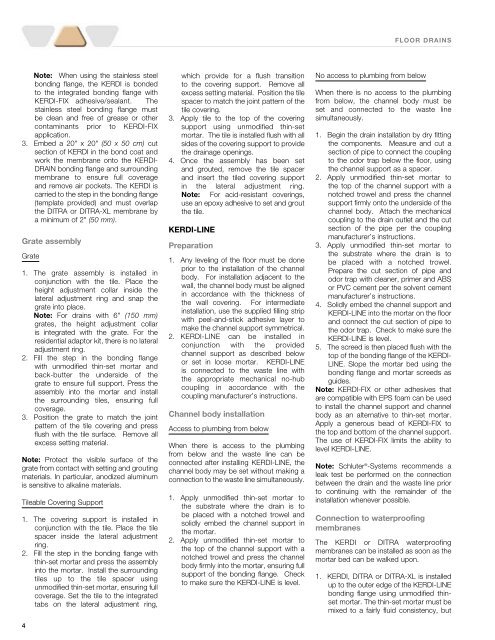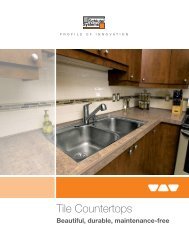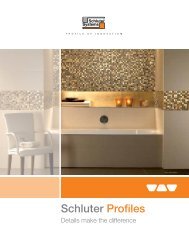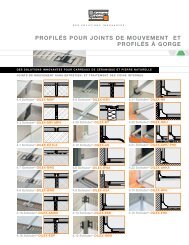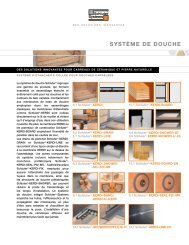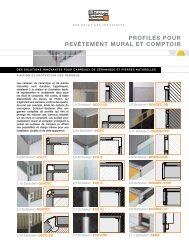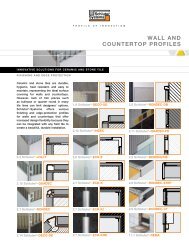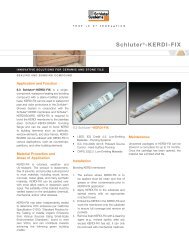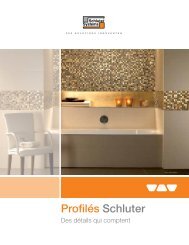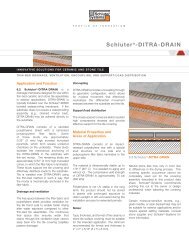You also want an ePaper? Increase the reach of your titles
YUMPU automatically turns print PDFs into web optimized ePapers that Google loves.
<strong>FLOOR</strong> <strong>DRAINS</strong><br />
Note: When using the stainless steel<br />
bonding flange, the KERDI is bonded<br />
to the integrated bonding flange with<br />
KERDI-FIX adhesive/sealant. The<br />
stainless steel bonding flange must<br />
be clean and free of grease or other<br />
contaminants prior to KERDI-FIX<br />
application.<br />
3. Embed a 20" x 20" (50 x 50 cm) cut<br />
section of KERDI in the bond coat and<br />
work the membrane onto the KERDI-<br />
DRAIN bonding flange and surrounding<br />
membrane to ensure full coverage<br />
and remove air pockets. The KERDI is<br />
carried to the step in the bonding flange<br />
(template provided) and must overlap<br />
the DITRA or DITRA-XL membrane by<br />
a minimum of 2" (50 mm).<br />
Grate assembly<br />
Grate<br />
1. The grate assembly is installed in<br />
conjunction with the tile. Place the<br />
height adjustment collar inside the<br />
lateral adjustment ring and snap the<br />
grate into place.<br />
Note: For drains with 6" (150 mm)<br />
grates, the height adjustment collar<br />
is integrated with the grate. For the<br />
residential adaptor kit, there is no lateral<br />
adjustment ring.<br />
2. Fill the step in the bonding flange<br />
with unmodified thin-set mortar and<br />
back-butter the underside of the<br />
grate to ensure full support. Press the<br />
assembly into the mortar and install<br />
the surrounding tiles, ensuring full<br />
coverage.<br />
3. Position the grate to match the joint<br />
pattern of the tile covering and press<br />
flush with the tile surface. Remove all<br />
excess setting material.<br />
Note: Protect the visible surface of the<br />
grate from contact with setting and grouting<br />
materials. In particular, anodized aluminum<br />
is sensitive to alkaline materials.<br />
Tileable Covering Support<br />
1. The covering support is installed in<br />
conjunction with the tile. Place the tile<br />
spacer inside the lateral adjustment<br />
ring.<br />
2. Fill the step in the bonding flange with<br />
thin-set mortar and press the assembly<br />
into the mortar. Install the surrounding<br />
tiles up to the tile spacer using<br />
unmodified thin-set mortar, ensuring full<br />
coverage. Set the tile to the integrated<br />
tabs on the lateral adjustment ring,<br />
4<br />
which provide for a flush transition<br />
to the covering support. Remove all<br />
excess setting material. Position the tile<br />
spacer to match the joint pattern of the<br />
tile covering.<br />
3. Apply tile to the top of the covering<br />
support using unmodified thin-set<br />
mortar. The tile is installed flush with all<br />
sides of the covering support to provide<br />
the drainage openings.<br />
4. Once the assembly has been set<br />
and grouted, remove the tile spacer<br />
and insert the tiled covering support<br />
in the lateral adjustment ring.<br />
Note: For acid-resistant coverings,<br />
use an epoxy adhesive to set and grout<br />
the tile.<br />
KERDI-LINE<br />
Preparation<br />
1. Any leveling of the floor must be done<br />
prior to the installation of the channel<br />
body. For installation adjacent to the<br />
wall, the channel body must be aligned<br />
in accordance with the thickness of<br />
the wall covering. For intermediate<br />
installation, use the supplied filling strip<br />
with peel-and-stick adhesive layer to<br />
make the channel support symmetrical.<br />
2. KERDI-LINE can be installed in<br />
conjunction with the provided<br />
channel support as described below<br />
or set in loose mortar. KERDI-LINE<br />
is connected to the waste line with<br />
the appropriate mechanical no-hub<br />
coupling in accordance with the<br />
coupling manufacturer’s instructions.<br />
Channel body installation<br />
Access to plumbing from below<br />
When there is access to the plumbing<br />
from below and the waste line can be<br />
connected after installing KERDI-LINE, the<br />
channel body may be set without making a<br />
connection to the waste line simultaneously.<br />
1. Apply unmodified thin-set mortar to<br />
the substrate where the drain is to<br />
be placed with a notched trowel and<br />
solidly embed the channel support in<br />
the mortar.<br />
2. Apply unmodified thin-set mortar to<br />
the top of the channel support with a<br />
notched trowel and press the channel<br />
body firmly into the mortar, ensuring full<br />
support of the bonding flange. Check<br />
to make sure the KERDI-LINE is level.<br />
No access to plumbing from below<br />
When there is no access to the plumbing<br />
from below, the channel body must be<br />
set and connected to the waste line<br />
simultaneously.<br />
1. Begin the drain installation by dry fitting<br />
the components. Measure and cut a<br />
section of pipe to connect the coupling<br />
to the odor trap below the floor, using<br />
the channel support as a spacer.<br />
2. Apply unmodified thin-set mortar to<br />
the top of the channel support with a<br />
notched trowel and press the channel<br />
support firmly onto the underside of the<br />
channel body. Attach the mechanical<br />
coupling to the drain outlet and the cut<br />
section of the pipe per the coupling<br />
manufacturer’s instructions.<br />
3. Apply unmodified thin-set mortar to<br />
the substrate where the drain is to<br />
be placed with a notched trowel.<br />
Prepare the cut section of pipe and<br />
odor trap with cleaner, primer and ABS<br />
or PVC cement per the solvent cement<br />
manufacturer’s instructions.<br />
4. Solidly embed the channel support and<br />
KERDI-LINE into the mortar on the floor<br />
and connect the cut section of pipe to<br />
the odor trap. Check to make sure the<br />
KERDI-LINE is level.<br />
5. The screed is then placed flush with the<br />
top of the bonding flange of the KERDI-<br />
LINE. Slope the mortar bed using the<br />
bonding flange and mortar screeds as<br />
guides.<br />
Note: KERDI-FIX or other adhesives that<br />
are compatible with EPS foam can be used<br />
to install the channel support and channel<br />
body as an alternative to thin-set mortar.<br />
Apply a generous bead of KERDI-FIX to<br />
the top and bottom of the channel support.<br />
The use of KERDI-FIX limits the ability to<br />
level KERDI-LINE.<br />
Note: <strong>Schluter</strong> ® -<strong>Systems</strong> recommends a<br />
leak test be performed on the connection<br />
between the drain and the waste line prior<br />
to continuing with the remainder of the<br />
installation whenever possible.<br />
Connection to waterproofing<br />
membranes<br />
The KERDI or DITRA waterproofing<br />
membranes can be installed as soon as the<br />
mortar bed can be walked upon.<br />
1. KERDI, DITRA or DITRA-XL is installed<br />
up to the outer edge of the KERDI-LINE<br />
bonding flange using unmodified thinset<br />
mortar. The thin-set mortar must be<br />
mixed to a fairly fluid consistency, but


